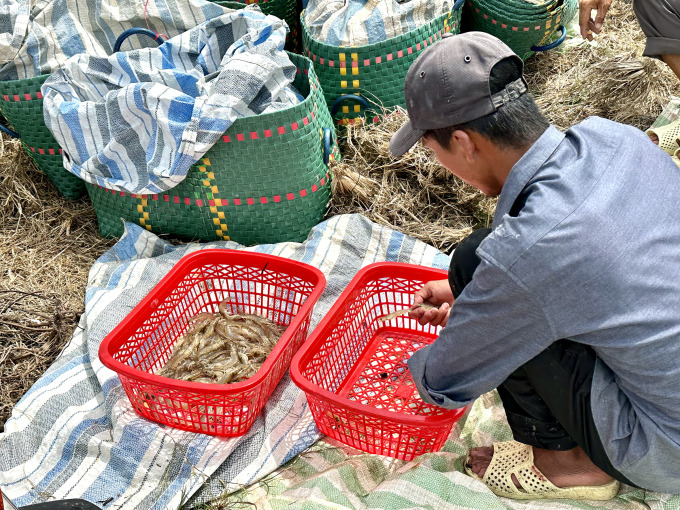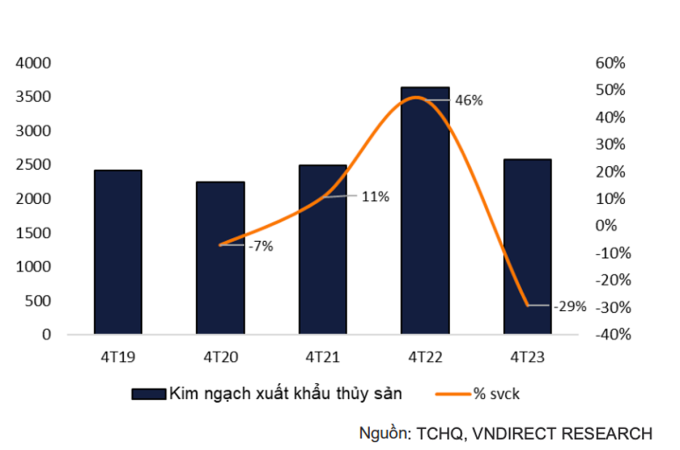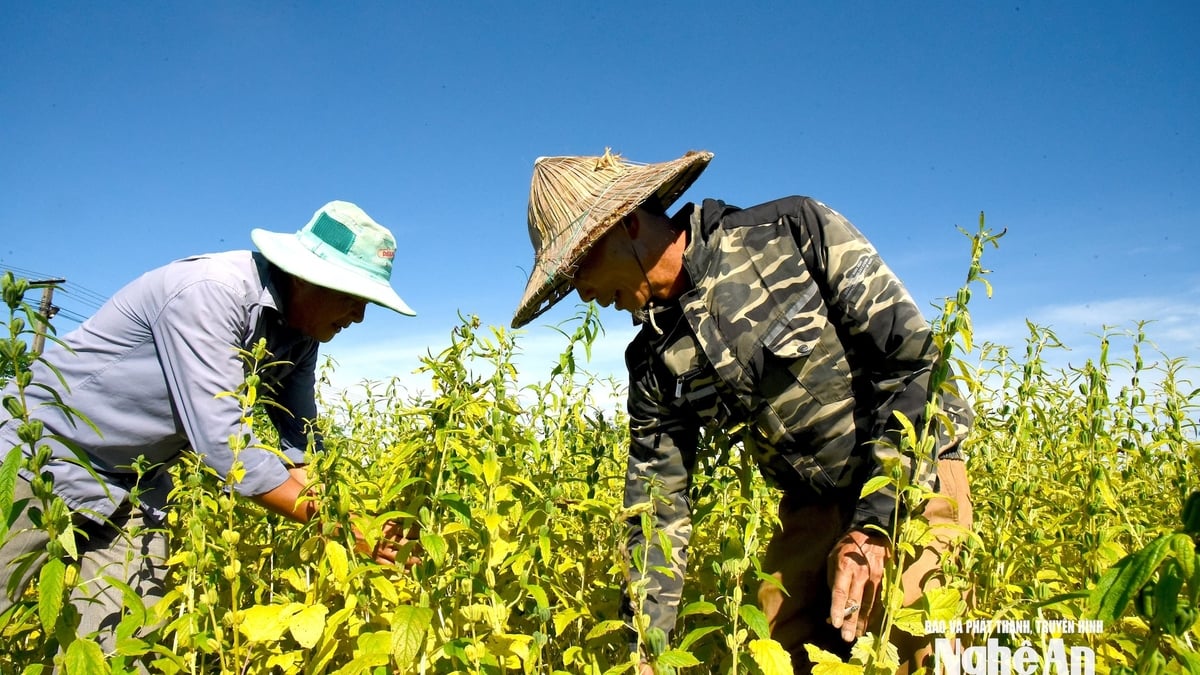After falling nearly 30% in five months, seafood exports in the second half of the year are expected to rely on consumption from the US and stable purchasing power from the EU.
In the second half of last month, traders bought 101-150 shrimp per kilo at Mr. Van Thu's pond (My Xuyen, Soc Trang ) for 65,000 VND. According to calculations, after 54 days of farming, Mr. Thu's shrimp crop only broke even. "There are many households in this village that are losing money, so anyone who makes a little profit is happy," he said.
In shrimp farming areas in Soc Trang and Bac Lieu , shrimp purchasing prices have plummeted for the past two months. "Shrimp prices are so unstable now!", commented Mr. Ba Duong - who has been raising shrimp for the past 20 years in Vinh Loi district ( Bac Lieu ). At the end of last year, the price of 30-per-kilo black tiger shrimp purchased by traders sometimes reached 200,000 VND per kilo.
But now, the purchase price drops by 2,000-3,000 VND per day, to less than 120,000 VND per kilo. "In big years like 2013-2014, shrimp farming could make a profit of 40-50%, but now if it can make 20-30%, it's very good," Mr. Duong commented.

Traders look at shrimp at Van Thu's pond on May 20. Photo: Dy Tung
Dr. Ho Quoc Luc, former Chairman of the Vietnam Association of Seafood Exporters and Producers (VASEP) and Chairman of the Board of Directors of Fimex, said that shrimp prices have been falling continuously and significantly over the past two months. So far, the decrease has been about 40% for all shrimp sizes.
In the first four months of the year, shrimp exports fell by 36% to $887 million, according to Vasep. According to the Agricultural Market Analysis and Forecast Center Agromonitor, the average price and volume of exported shrimp decreased by 9% and 29%, respectively, compared to the same period last year. The reason was weak demand and fierce competition from Ecuador and India.
Along with shrimp, pangasius exports decreased by 23% in volume and 34% in value in the first quarter of the year. According to the General Statistics Office, seafood exports in the first 5 months of the year reached nearly 3.4 billion USD, down 28% compared to the same period in 2022. This affected the business results of enterprises in the industry.
VNDirect Securities Company estimates that the total revenue of listed seafood enterprises in the first quarter decreased by 32% compared to the same period in 2022, due to a sharp decrease in average selling price and export volume. The industry's gross profit margin narrowed by 5.1 percentage points while production costs continued to be high. As a result, the total net profit of enterprises decreased by 74% compared to the same period.

Seafood exports in the first 4 months of recent years. Graphics: VNDirect
In Vinh Loi district, Mr. Duong said that the purchasing power of export processing enterprises is still weak. The main output is traders buying "oxygenated shrimp" (live shrimp aerated with oxygen for transport to buyers) to sell domestically. "But the demand is also low, so they choose very carefully and do not buy everything in the pond like when there was a boom in demand," he said.
Assessing the prospects for the second half of the year, VNDirect forecasts that the US market will recover positively thanks to three reasons: cooling inflation, reduced inventory levels and high demand during the year-end holidays. This will help Vietnam's seafood export turnover to the US increase by 40-50% in the second half of the year compared to the first half. The US is currently Vietnam's second largest market after Japan.
"We saw signs of recovery in this market in May, when the average export price of pangasius tended to increase and US inflation showed signs of cooling down," said the VNDirect analysis team. Last month, the US CPI was 4.9%, the lowest increase in the past two years and lower than market expectations.
The EU market also has stable consumption. In the first quarter, export turnover to this market only decreased slightly by 4% because Europeans prefer Vietnamese white fish at reasonable prices in the context of high inflation and tight spending.
Most markets in the EU increased imports of Vietnamese pangasius, with many markets recording double-digit growth: Romania (36%), Sweden (53%), Denmark (34%), Bulgaria (49%). Some smaller markets even recorded triple-digit growth, such as Germany (100%), Lithuania (429%), and Finland (436%).
According to Agromonitor, the average price of pangasius exported to the EU in the first quarter increased by 9.5% compared to the same period last year. Therefore, experts expect that the demand for Vietnamese pangasius in the EU will be stable in the second half of the year as inflation in the EU remains high.
For China, Vietnam’s seafood exports to this country are not as high as expected, with the first 4 months reaching 364 million USD, down 30% compared to the same period. Vietnam’s market share has also decreased significantly. In particular, shrimp is facing strong competition from Ecuador and India, when this country increased its purchases while reducing orders for Vietnamese shrimp.
Chinese people are having a more cautious consumer mentality in the second half of 2023. Due to the unpredictable macroeconomic foundation of the Chinese economy and fierce competition from other countries, VNDirect forecasts that seafood exports to China in the second half of the year will not grow as strongly as in the past 6 months.
However, there is still hope for this market. Recently, the Vietnamese Ministry of Agriculture and Rural Development said that it will coordinate with the Yunnan Customs Department to propose to the General Administration of Customs of China to add fruit and seafood products, and at the same time allow Vietnamese live seafood to be exported through Yunnan province's border gates.
According to Ms. Le Hang, Communications Director of Vasep, the Chinese market is showing more positive signs, especially after the Spring Festival, the tourism sector is attracting more Chinese people, as well as international tourists. It is expected that from this summer, the market will gradually become vibrant again.
Di Tung
Source link



























![[Photo] National Assembly Chairman attends the seminar "Building and operating an international financial center and recommendations for Vietnam"](https://vphoto.vietnam.vn/thumb/1200x675/vietnam/resource/IMAGE/2025/7/28/76393436936e457db31ec84433289f72)









































































Comment (0)